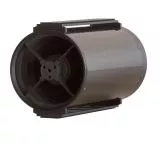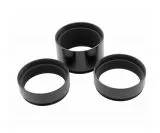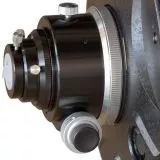- Details
- More images
Products description

This telescope is checked, measured and adjusted if necessary before delivery. The focuser is set.
How we adjust: About us
Please contact for advice on this telescope. So you can benefit from our experience before buying
GSO 10 "f / 8 Ritchey-Chrétien 254mm 2000mm RC - Carbon Tubus
10 "f / 8 RC Astrograph - 254mm aperture / 2000mm focal length - With carbon tube
RC telescope for astrophotography and observation at a high level - with 3 "MONORAIL excerpt
Until now, true RC telescopes were not only known for their good optical data, but above all for their high price. The well-known US manufacturer "Astro-Tech" then commissioned GSO, which is known for very good mirror optics, with the production of two genuine RC (Ritchey Chrétien) telescopes. The result is real astrographs, well above the level of typical Schmidt Cassegrains, at an affordable price. Teleskop-Service has taken over the distribution of these devices from GSO in Germany and Austria.
In addition to the inexpensive standard version with metal tube, we also offer the RC in a Deluxe version with carbon tube.
The advantages of the Carbon Deluxe Version:
- less weight (only 14,6kg)
- No tube change in case of strong temperature fluctuations.
The advantages over the metal tube are minimal, but the price difference is considerable. So everyone has to decide for themselves whether the carbon tube is worth the extra cost.
The 10 "f / 8 RC Astrograph illuminates about 60mm field very well.Without corrector lens you have a field with about 30mm diameter with very good correction available.You have a pure reflection system, so you do not need an IR cut filter and can also use the infrared light of the objects, the CCD chips are relatively sensitive in this area.
The image is completely free from color aberrations and the resolution is higher than that of most apochromatic refractors in this price level.
The most important data:
- Optical design: real RC system consisting of a hyperbolic main and secondary mirrors.
- Optical data: opening 10 "(254mm)
- focal length 2000mm
- aperture ratio f / 8
Main mirror: made of quartz - surface quality 1/12 lambda or better - The main mirror is permanently installed in the tube. The main mirror is provided with a 99% reflection layer and dielectrically tempered.
Mirrors: made of quartz with 99% reflection - the secondary mirror is mounted in a robust cell that is adjustable. Shading by the Fangspiegel with bracket is 112mm.
Tube: Carbon Tubus - Main and secondary mirror cells are made of metal. Tube weight 14,6kg
- Tube length: 735mm incl. Focuser
- Tube diameter 294mm
Computer-optimized inner panels: The inner tube is provided with inner panels, which prevent the ingress of stray light.
The 3 "monorail focuser: The focuser is a definite improvement over Crayford drawers, which are mounted along a solid stainless steel rail that provides significantly more rigidity than the four tightly dimen- sioned ball bearings of a Crayford pull-out.
The focal plane is 110mm behind the 2 "adapter - so enough space for different accessories.
Mount adaptation: At the base of the RC telescope is a prism rail, which has 3 "Losmandy level, so that fits the RC to any Losmandy mount and of course mounts with identical recording, such as CGE, CGEM Celestron.
The 3 "monorail excerpt of the RC10
GSO RC10 3z Monorail Extract
Picture shows the white metal tube!
The big 3 "monorail pullout of the RC is a further development of the Crayford pullout.The load no longer rests on four, often undersized, ball bearings, but on a solidly mounted and laterally guided stainless steel rail at the base .This prevents tilting of the pullout even at high It is countered by a large knurled screw (picture left) which presses the inner tube exactly centrically onto the rail, so that the load is evenly distributed evenly over the rail.
Technical specifications:
- Adjustment range: approx. 80mm
- Free opening: 68mm
- Guide: solidly mounted and fixed stainless steel rail - over running surfaces
- 1:10 reduction for exact focus
- 360 ° rotation at the end of the extract
- Adapter to 2 "and (if unscrewed) M69 female thread (fits the TSOAG25 - 2.5" Off Axis Guider)
The location of the focus:
Although the 10 "RC is mainly built for astrophotography but also the observation is possible.The focal plane is about 110mm behind the 2" stop. Thus, Reducer lenses and correctors can be used.
Technical specifications:
- RC system consisting of 2 mirrors
- Opening 254mm
- focal length 2000mm
- aperture ratio f / 8
- Reflection on both mirrors 99% with the diel. protective layer
Delivery:
- 10 "F / 8 RC Astrograph
- 3 "focuser with reduction to 2" and 1.25 "
- Prism Rail Losmandy Level
The advantages of the GSO RC compared to systems with advanced corrector plate:
- pure reflection system with good field corrector (when using a DSLR no corrector is needed)
- also infrared photography is possible
- good photographic aperture ratio of f / 8
- no problems with dewing - that is a big problem of all systems with front corrector plate
- faster cooling because the RC is an open system
- brighter picture due to 99% mirroring of both mirrors
- Quartz mirrors (like Zerodur) - no problems with temperature adjustment
- no shifting problems when focusing - through the monorail extract (improvement to the Crayford
Transport of the 10 "RC:
We offer Geoptik a padded carrying case for the 10 "RC This bag (item number 30A037) is built for 11" Schmidt Cassegrains. Since the 10 "RC is a bit longer, the Okularauszug would have to be removed for transport, but it works thanks to the union nut within seconds.
The optical advantages of astrographs from GSO
Optical Design - Ritchey Chrétien / RC
The GSO Astrograph is a true Ritchey-Chrétien reflector. In contrast to Maksutovs or Schmidt Cassegrains, which use spherical mirrors and corrector lenses, or Newton's, who need a coma corrector for astrophotography, the RC system is a pure reflection system with no color aberration, which works with two mirrors.
The RC system has a concave hyperbolic primary mirror and a convex hyperbolic secondary mirror.
The result is a comfree and large field of view, free of disturbing aberrations, which can be used for astrophotography but also for observation. The sharpness on the axis is higher and the usable field of view is larger than that of typical SC telescopes, Maksutovs or Newton's.
Because of these advantages, the Ritchey Chrétien system is mostly produced for astrophotography. This system is mostly used by professional large telescopes. Examples of RC systems are the 10 meter Keck telescope in Hawaii or the modern four 8.2 meter telescopes of the VLT in Chile. Now this system is also available to the amateur without NASA budget for a moderate price.
Mirror with 99% reflection and a dielectric protective layer
The main mirror of the 6 "RC telescope is made of homogenous BK7 material.The main mirror of the 8" RC is made of quartz material, which, like Zerodur, has no disturbing expansion value. The main and secondary mirrors are provided with a 99% reflection layer, which is protected against scratches and aging by a dielectric layer. The result is a much brighter picture than comparable devices.
Every optic is tested by the manufacturer
In order to maintain a consistently high level of quality, every look is corrected by hand after automatic production. Then an individual test is performed on a Zygo interferometer. Even at TS, before shipping, every look is checked again. This guarantees that you only get very good looks that will give you pleasure for many years to come.
The mechanical advantages of astrographs from GSO:
Fixed and adjustable main mirror cell and computer-optimized inner panels
In contrast to conventional systems, where the main mirror is moved, the main mirror of the GSO RC telescopes is fixed. This prevents unwanted shifting and the optics are always optimally centered. Within the tube and the baffle tube, there are computer-optimized apertures, which further increase the contrast and prevent the ingress of stray light.
Adjustment of the system via the secondary mirror and primary mirror - very adjustment stable
Since the primary mirror is very easy to adjust in its optimized position, the adjustment can be achieved effectively and easily via the secondary mirror. The adjustment process is very simple and can be done by inexperienced amateur astronomers. The adjustment of the main mirror is done at each RC before shipment on our optical bench.
This Product was added to our catalogue on 31/10/2013.
Categories
Quick purchase
Welcome back!
Last viewed:
Manufacturer
Shipping country






